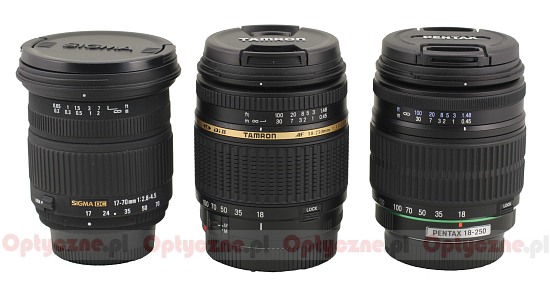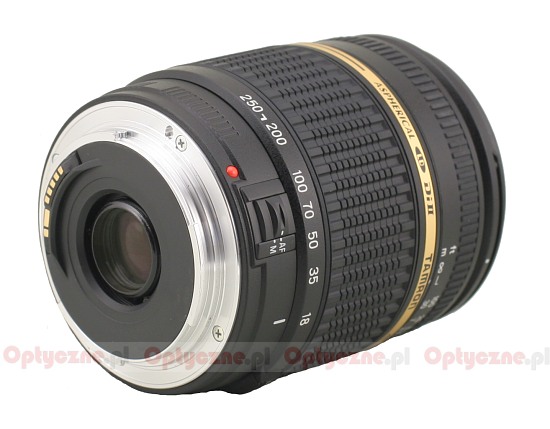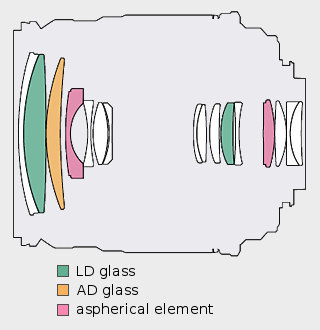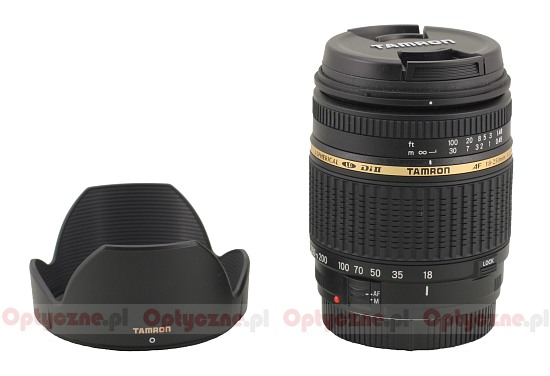Tamron AF 18-250 mm f/3.5-6.3 Di II LD Aspherical (IF)
3. Build quality
 |
Moreover, the following chart shows that neither the dimensions nor the weight of the tested lens are much different from those of other instruments with similar parameters.
Please Support UsIf you enjoy our reviews and articles, and you want us to continue our work please, support our website by donating through PayPal. The funds are going to be used for paying our editorial team, renting servers, and equipping our testing studio; only that way we will be able to continue providing you interesting content for free. |
- - - - - - - - - - - - - - - - - - - - - - - - - - - - - - - - - - - - - - - - - - - - - - - -
The build quality is typical for the Tamron lenses of this class. If you have had any experience with other models from this manufacturer, like a 17-50 f/2.8 or a 18-270 VC, you will clearly see that it’s the same quality level – perhaps not the highest one, because rubber elements dominate the outside part of the barrel, but also not the lowest one, because in some key places we’ve got metal.
 |
This metal we’ll find in the bayonet mount the lens begins with. Then we see an autofocus mode switch (AF/MF) and the focal lengths scale, next to which is situated a LOCK switch, used to block the lens when collapsed (at 18 mm). What a pity the producer didn’t include the possibility of it working at any focal length, because the lens has a constant “zoom creep” tendency – it is collapsing or extending under the weight of the front element. After the LOCK switch, we’ll find a solid, big and ribbed zoom ring. It’s action is uneven – it moves loosely in the range of 18-70 mm, then more stiffly in the range from 70 to 200mm and again rather loosely in the range of 200 – 250 mm. In consequence, if we put the zoom in a loosely working focal length range, even the slightest lens movement might result in a sudden “zoom creep” and the focal length change. Sometimes it is annoying.
What’s more, it’s not the end of the annoying things. Sometimes the lens transmits to the body a very strange information about the focal length value. For example, while doing distortion test at 35 mm I found with a surprise that in the data, saved in EXIF, I had the 55 mm focal length! A huge difference!
Behind the zoom ring we find a gold strip with the name of the lens, then a manual focus ring with the distance scale marked in feet and meters. The ring could have been bigger and more comfortable and it could have worked less loosely – in the current state we can hardly call its work comfortable and smooth.
The lens ends with a non-rotating filter thread with a diameter of 62 mm, which surrounds the front element. That element, while zooming, extends so far on a telescopic barrel that at 250 mm the lens practically doubles its dimensions.
Inside the Tamron 18-250 mm there are 16 elements in 13 groups. Three of them are made of the low dispersion glass (LD - Low Dispersion and AD - Anomalous Dispersion), and their task is to correct the diagonal and horizontal chromatic aberration. Additionally, in the Tamron we’ll find two hybrid aspherical elements and a circular aperture diaphragm with seven blades which can be closed, depending on the focus, to f/22-40.

The buyer gets both caps and a petal-type lens hood in the set.
 |






